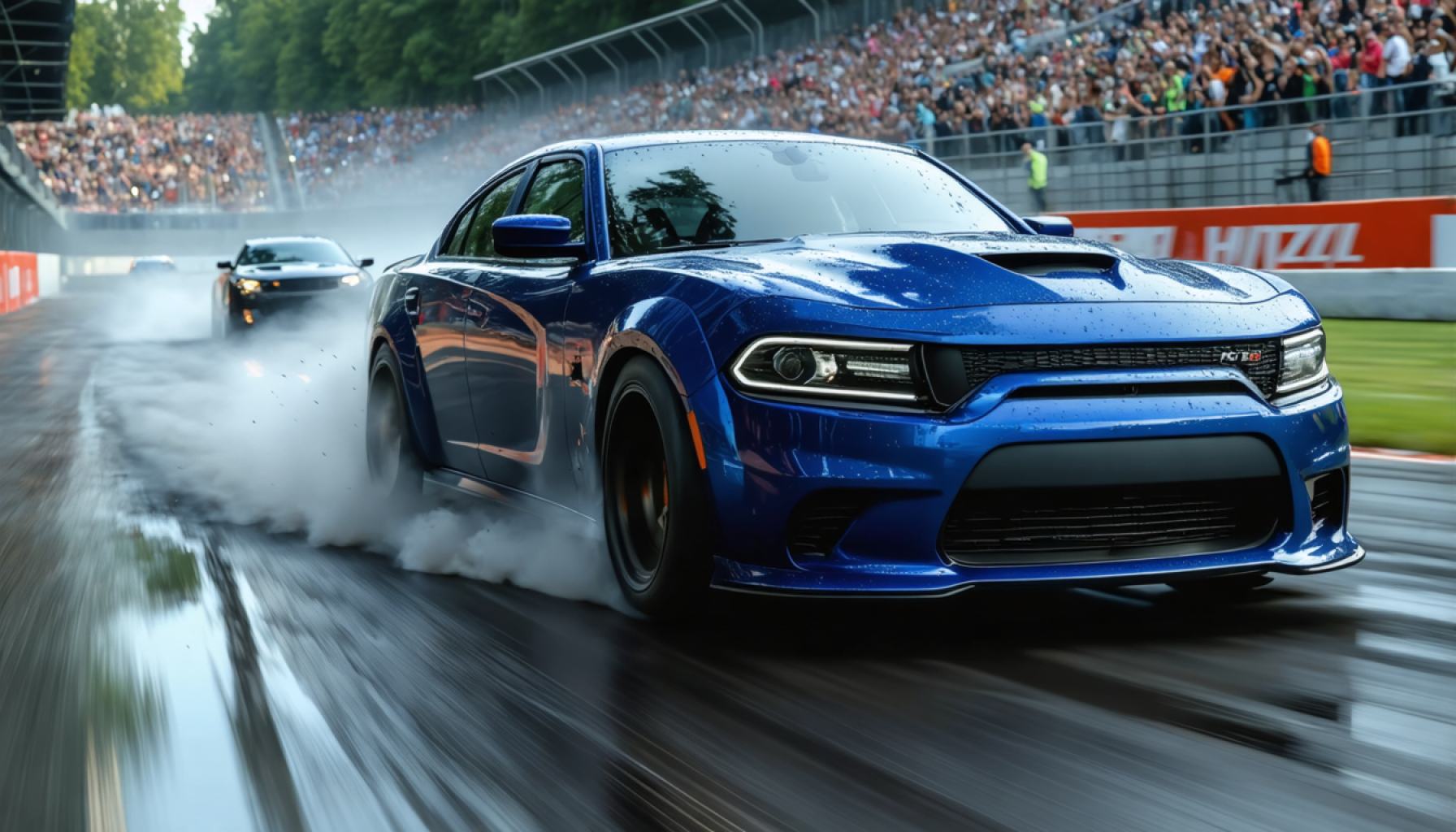- A classic Dodge Charger faces off against Ford’s cutting-edge electric vehicle (EV) on a sunlit raceway, showcasing a clash between past and future automotive technologies.
- The Dodge Charger, a symbol of 1970s American muscle, relies on its powerful internal combustion engine, embodying nostalgia for an era when muscle and raw power reigned supreme.
- Ford’s EV exemplifies modern automotive advancements, featuring quiet, efficient acceleration and emphasizing agility, precision, and environmental responsibility.
- The race demonstrates a broader narrative of technological transition, highlighting a shift from brute force to sustainable, electrified power.
- The event suggests that adaptability is crucial for legendary brands as innovation transforms power and speed dynamics in the automotive world.
The air was tense with anticipation as two legendary automotive brands prepared for a showdown on a bright, sun-drenched raceway. On one side, the classic roar of the Dodge Charger, a vehicle deeply rooted in the lore of 1970s American muscle cars, stood ready to demonstrate its enduring might. Across from it, the sleek, futuristic lines of Ford’s cutting-edge electric vehicle (EV) buzzed with quiet but undeniable energy—an embodiment of next-generation power.
As the light turned green, the familiar growl of the Charger pierced the air, its engine a symphony of internal combustion. This classic icon, metaphorically dusting off its wide-brimmed racing hat, launched forward with all the nostalgia of its storied past—an era where muscle was king and raw power spoke volumes. The Charger was not just racing another car; it was challenging the very notion of its potential obsolescence in the face of advancing technology.
However, the Ford EV was no mere adversary; it was a revelation. With the serene whisper of its electric hum, the Ford surged ahead, its speed almost ghostly in its quiet swiftness. The sleek, aerodynamic frame sliced through the air, propelled by the sheer efficiency of its electric motor. It was a testament to how far automotive engineering had leaped into the future—a vehicle that embodies agility, precision, and environmental consciousness.
The Charger, though gallant in its effort, soon found itself outpaced by this mechanical marvel from Ford. Each attempt to close the gap was met with the EV’s effortless acceleration, showcasing a new era where torque and power are delivered with a silent, sustainable ferocity.
This extraordinary race was more than a simple clash of cars. It was a narrative of transition—a vivid illustration of how technology and innovation are redefining our understanding of power and speed. The Dodge Charger may still wear its crown with pride, a symbol of an unforgettable era of automotive history. Yet, the future gushes forth like the wind, carrying the promise of innovation and progress in fuel efficiency and environmental responsibility.
As the two cars wound down the track, the takeaway was clear. In this era of rapid technological advancement, even the legends must adapt or watch as the future races ahead. For the automotive enthusiast and the casual observer alike, the race signified that the triumph of agility over brute force is not just a possibility—it is an electrified inevitability.
Electric vs. Muscle: The Unstoppable Evolution of Automotive Power
Introduction
The electrifying race between the Dodge Charger and Ford’s electric vehicle (EV) captivated audiences, highlighting the clash between traditional muscle cars and cutting-edge electric technology. This event did more than just entertain; it presented a narrative of technological evolution and a shift in the automotive industry’s values.
How-To Steps & Life Hacks: Embracing EV Technology
1. Understanding EV Benefits: Electric vehicles offer lower running costs and reduce the carbon footprint. They produce zero emissions and boast high efficiency with instant torque for rapid acceleration.
2. Setting Up Home Charging: Install a Level 2 charger for faster home charging. Consider solar panels to power your EV sustainably.
3. Maximizing Range: Learn to drive efficiently by maintaining steady speeds, utilizing regenerative braking, and minimizing use of the HVAC system.
Real-World Use Cases
EVs are particularly ideal for urban commuting due to their ability to handle stop-and-go traffic efficiently. Muscle cars like the Dodge Charger still hold appeal for enthusiasts who enjoy the visceral experience of driving.
Market Forecasts & Industry Trends
The global EV market is rapidly expanding, with a compound annual growth rate projected to exceed 20% through 2030, driven by stricter emission regulations and advances in battery technology. Meanwhile, interest in muscle cars remains strong in niche markets, emphasizing heritage and performance.
Pros & Cons Overview
Electric Vehicles:
– Pros: Environmentally friendly, cost-efficient in the long term, quiet operation, rapid acceleration.
– Cons: Higher initial purchase cost, range anxiety, charging infrastructure still developing.
Muscle Cars:
– Pros: Iconic design, powerful engine sound and performance, strong cultural legacy.
– Cons: Lower fuel efficiency, higher emissions, potential for obsolescence in evolving climates.
Controversies & Limitations
While EVs are touted for sustainability, their production, particularly battery manufacturing, has environmental impacts. Conversely, muscle cars face criticism for their high emissions but continue to innovate with features like hybrid powertrains to reduce their carbon footprints.
Features & Pricing
Modern EVs like Ford’s models include advanced tech features such as autopilot capabilities and seamless smartphone integration. The pricing spectrum is broad, from accessible models to luxury options, allowing diverse consumer access. In contrast, muscle cars maintain a focus on performance features, with pricing often linked to horsepower and special editions.
Insights & Predictions
The future of the automotive industry is a harmonious blend of sustainability and performance. EVs are poised to become mainstream, with technological advances likely to lower costs and improve charging infrastructure. Meanwhile, muscle cars may integrate hybrid technology to stay relevant.
Actionable Recommendations
– For Potential EV Buyers: Test drive multiple EV models to understand features that matter most to you. Research local and federal incentives for tax credits.
– For Muscle Car Enthusiasts: Consider hybrid models that offer improved efficiency. Stay informed on retrofitting options for classic models to improve performance and reduce environmental impact.
For more automotive insights, explore Ford and Dodge.
